LISTERINE® Antiseptic: A Very Useful Product
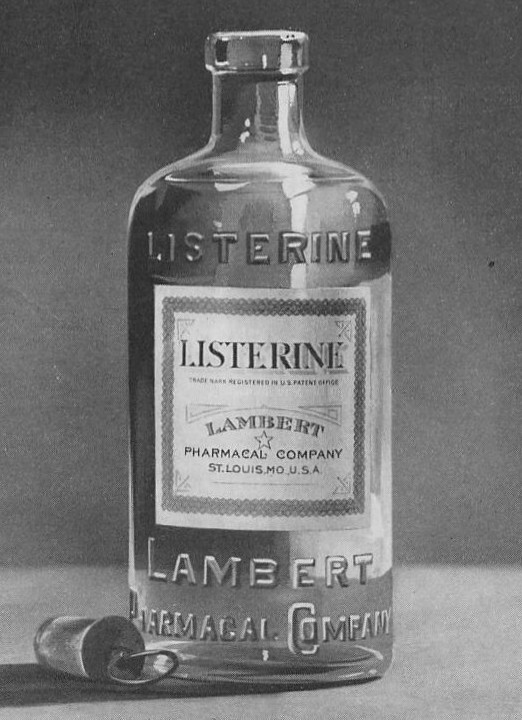
Johnson & Johnson was founded in 1886. But this product – our oldest – dates from 1879. How is that possible? And what’s more, how did a product that started as a surgical disinfectant end up as a mouthwash?
The product is LISTERINE® Antiseptic, and it became part of our consumer product portfolio with the acquisition of Pfizer Consumer Healthcare in 2006. Despite its recent tenure with the Company, our new oldest product has something in common with the first products made by Johnson & Johnson: it was inspired by Sir Joseph Lister.
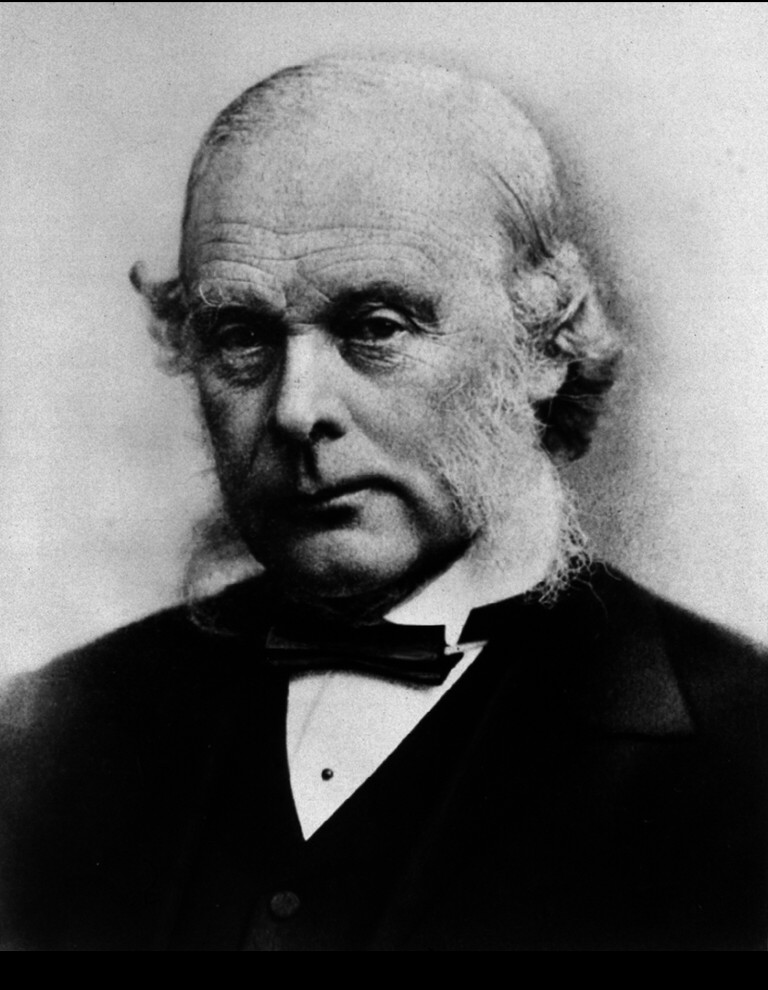
Sir Joseph Lister
Lister was an English surgeon who, in the 1860s, applied Louis Pasteur’s theory that invisible germs caused infection, and pioneered antiseptic surgery. He inspired Robert Wood Johnson and his brothers to start Johnson & Johnson to make the first sterile surgical dressings, and he also influenced a doctor from St. Louis, Missouri named Dr. Joseph Lawrence.
In 1879 Lawrence formulated an antiseptic liquid, naming it “Listerine” in honor of Dr. Lister. Lawrence’s surgical disinfectant had germicidal properties without being harsh or irritating, and was initially advertised for a whole range of uses, such as cleaning cuts and abrasions, as an antidote to dandruff and athlete’s foot, and as a soother of insect bites. Like the Johnson brothers, Lawrence was concerned with manufacturing and packaging products that could be used by doctors to improve public health. In keeping with Lawrence’s high standards, the product listed its ingredients on the label. According to the November, 1952 issue of Modern Packaging Magazine, it was either the first, or one of the first products ever to do so.
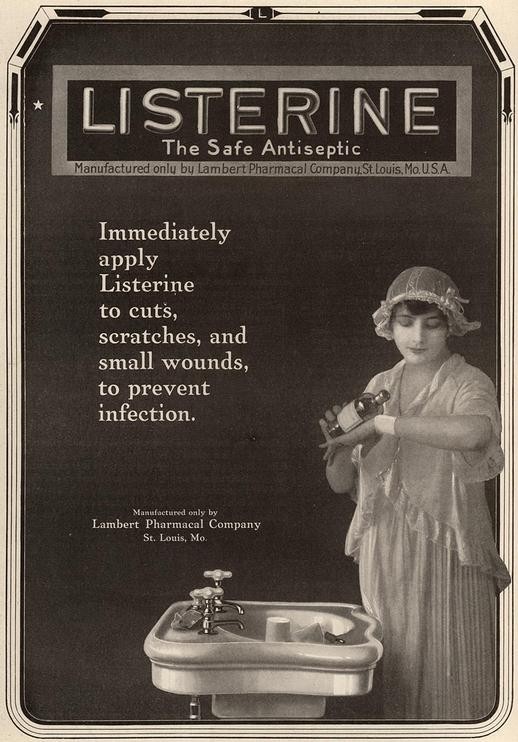
Lawrence purchased his product’s ingredients from a local St. Louis pharmacist, Jordan Wheat Lambert. In 1881, Lambert licensed the formula for LISTERINE® from Lawrence and formed the Lambert Pharmacal Company. In 1895, Lambert started marketing the product to dentists as an oral antiseptic. An early, undated ad listed the product’s virtues as being “Antiseptic, Prophylactic, Deodorant, Non-Toxic, Non-Irritant, Non-Escharotic, Absolutely Safe, Agreeable, Scientific and Strictly Professional.” The ad called LISTERINE® a pharmaceutical specialty for dentists, and listed a use in small print that would become more and more important later: LISTERINE® could get rid of bad breath.
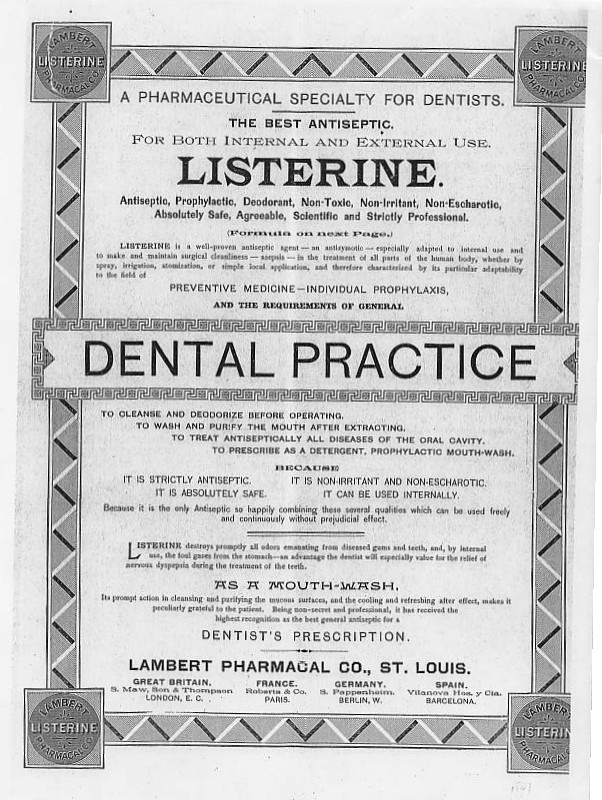
LISTERINE® was available only to the medical profession until 1914, when it started to be sold to consumers…and it sold steadily if unspectacularly. So the people at the Lambert Pharmacal Company looked around for ways to generate more interest in their product. And the ones who came up with an idea were Jordan Lambert’s sons.
The Lambert brothers were sure that their product would sell better if they could find something that would make it indispensable to people. So in 1921 they asked the Lambert Pharmacal Company chemist to list all of the things for which the product was helpful. One of the items on his list was the fact that LISTERINE® could eliminate what he politely called “halitosis.” “Halitosis” is derived from the Latin word for “breath,” and the Lambert brothers most likely chose to use the word because it sounded scientific and would elevate bad breath from being a personal nuisance to an official-sounding social condition that could be cured by using their product.
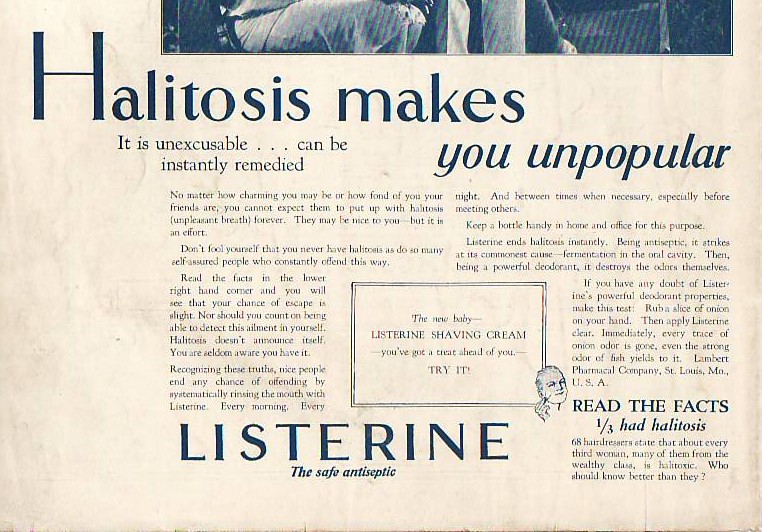
Since virtually everyone was sensitive about the possibility of having bad breath, the new advertising hit a nerve with the public, and sales took off.
A typical ad from 1928 (shown above) was titled, unsubtly, “Halitosis makes you unpopular.” It began by trying to catch readers’ interest by playing on their insecurities:
“No matter how charming you may be or how fond of you your friends are, you cannot expect them to put up with halitosis (unpleasant breath) forever. They may be nice to you – but it is an effort.” [1928 Ad, "Halitosis Makes You Unpopular]
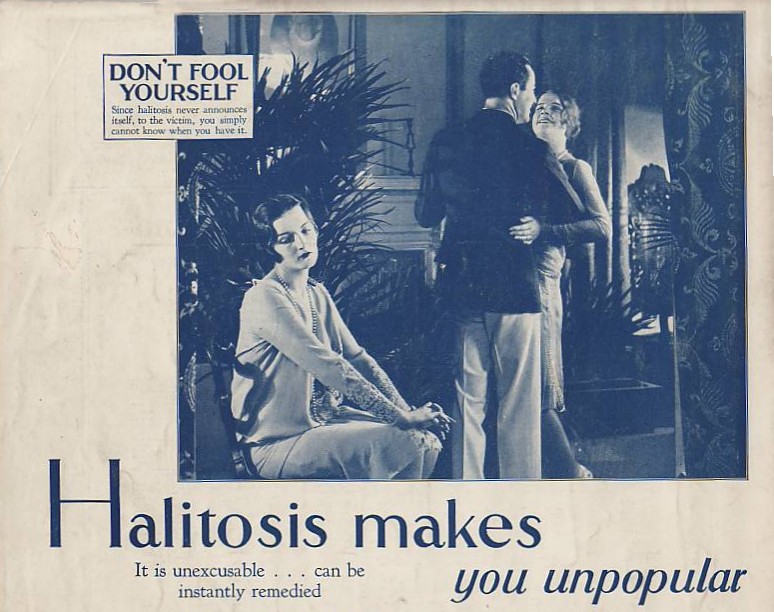
Now that the ad had the reader’s attention, it went on to say that the problem could be remedied by using LISTERINE®.
Perhaps the most famous ad campaign for the product dates from the 1930s and showed a weeping girl, with the phrase, “Often a bridesmaid, never a bride.”
Here’s another ad with the bridesmaid theme.
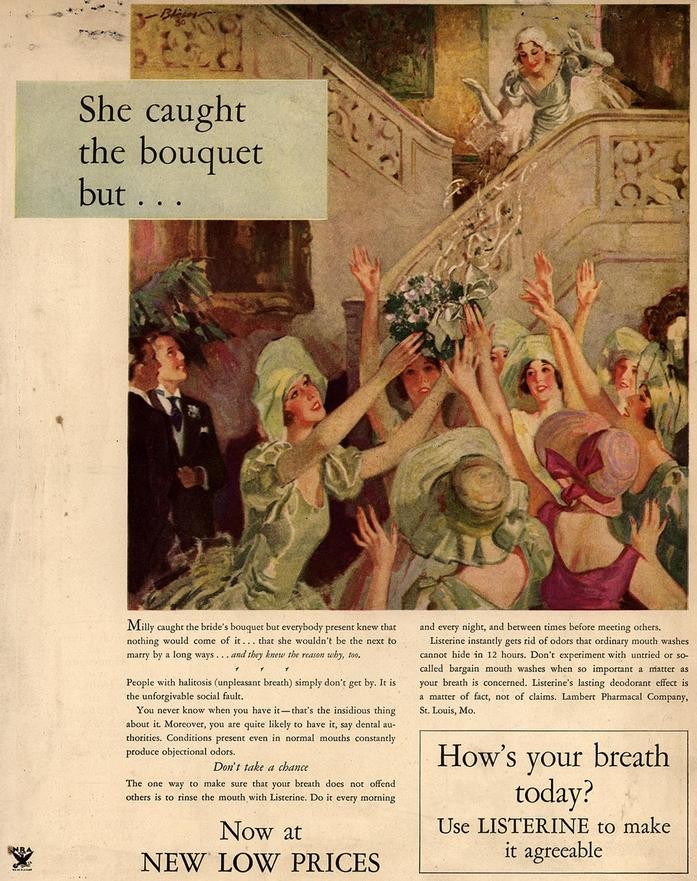
Some of the product’s advertising held echoes of its original purpose as a surgical disinfectant, such as ads urging its use to disinfect small cuts, or this excerpt from an ad from the 1920s encouraging consumers to dab LISTERINE® under their arms to use as a deodorant.
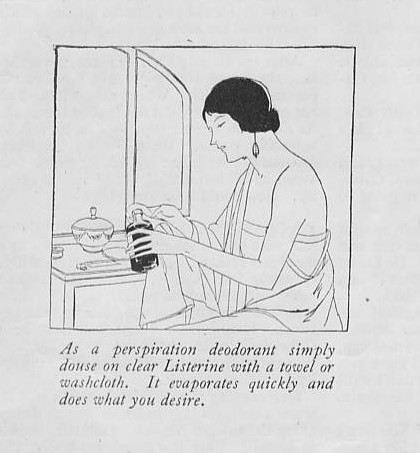
Or this ad, alerting men to the potential dangers of shaving:
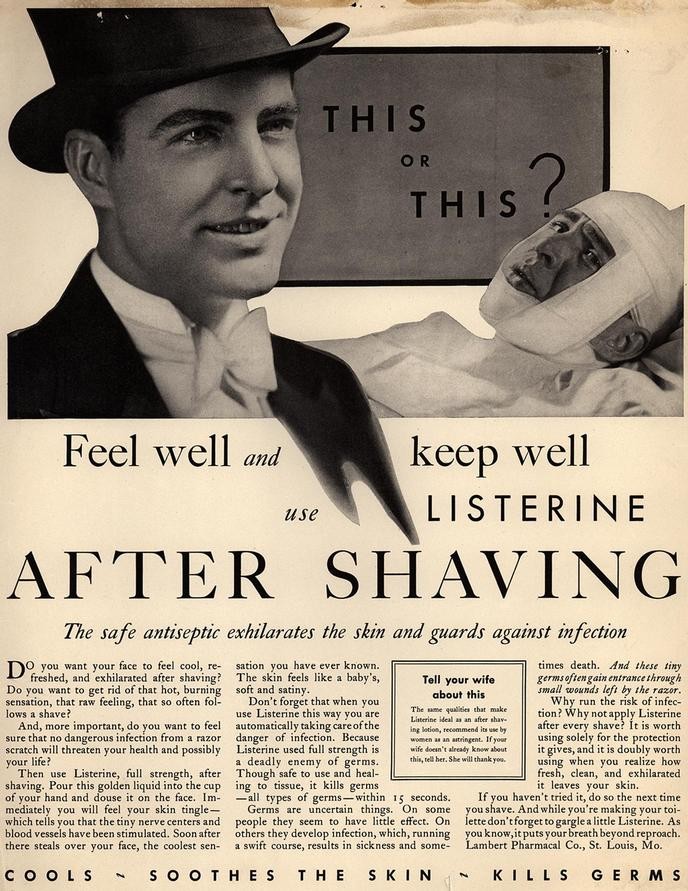
For most of its history, LISTERINE® was packaged in glass bottles with the name of the product embossed above the label.
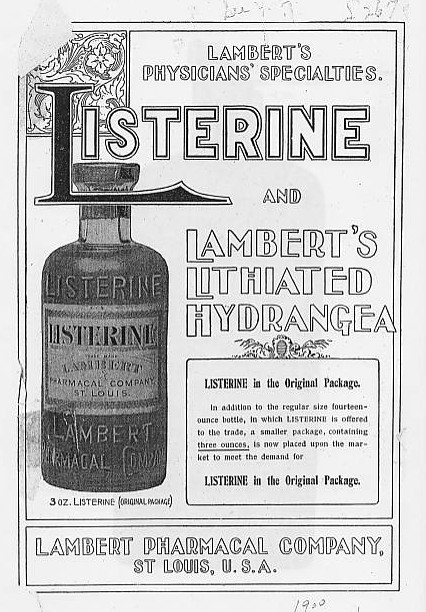
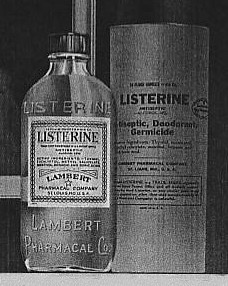
Examples of Earlier Packaging: Bottles with Cork Stopper (L) and Cap (R)
The early cork stoppers were replaced by a more modern screw-on cap, but the packaging remained largely unchanged -- and reminiscent of the product’s original medical mission -- until plastic bottles were introduced in 1994. Over the years, the advertising gradually shifted, with some ads taking a humorous theme. One famous ad showed a bottle of LISTERINE® next to a grotesque statue on the top of Notre Dame Cathedral in Paris, France. The three-word caption read “Gargoyle with Listerine.” Today, the product’s advertising focuses on promoting oral health.

I am looking for a good example of the "Gargoyle with Listerine" ad. It can be either original or a reproduction. Any idea where this can be found? Thx.
It's a great ad, isn't it? Unfortunately, I don't have an idea where you can find the Gargoyle ad. (All I have is a copy someone had made --I don't have an original -- which is why I didn't put a picture of the ad in the post. You can try places that sell old magazines or ads, or even eBay to see if it comes up.)
I was just hiking on our property in the woods of Downeast Maine and stumbled across one of these glass bottles in perfect condition (minus the paper label of course)thanx for the bit of historical info.
I am now going to think of your page every morning when I gargle with listerine!
Drew
Hey I found one of the bottles like is pictured on the first page of this site in perfect condition I was just wondering if it has any value other than historical, Or if it is worth anything to the Listerine company. It was found in central Missouri.
Crystal,
I don't know what the value of your bottle would be to a collector. It would depend on the rarity and the condition. There were a great many LISTERINE® bottles produced, so the value may be mostly historical. You can probably look at some of the antique bottle collector sites on the internet to get an idea. We have a company museum and may be interested in your bottle. Please e-mail me through the blog -- a link to the e-mail is in the "About the Author" page of the blog, which can be found here: http://www.kilmerhouse.com/?page_id=46
Thanks,
Margaret
Hi, i also have one of the original type bottles that had the cork stopper. i live in sydney australia. i was wandering if there is any way of getting a more accurate date for the bottle. It has 7N on the base of the bttle.
thanks
Hi Victor,
I don't have a lot of information on LISTERINE® because the product came to the Johnson & Johnson Family of Companies in 2006. But from what I do have, I can tell you that LISTERINE® bottles used cork stoppers from the product's beginning until the 1930s, when they went to threaded caps. So your bottle would be pre-1930s. There are many internet sites dedicated to antique bottles, and many of them may have more specific information or could point you to someone who could further narrow down the dates for your bottle. Here's one on finding the dates of antique bottles that might be helpful: http://www.antiquebottles.com/dating.html
Best of luck!
Margaret
does anyone have any information regarding the formulation history of Listerine? How different is the current mouthwash from the original?
Alan,
I checked with some of the folks who work on the LISTERINE® brand, and they said that the product contains the same fixed combination of essential oils as the original, but there are minor differences in the buffers and the manufacturing process.
Margaret
I happen to have a framed picture of the Gargoyle with listerine ad. I never really thought it might be of some value. Please let me know!
Tyler
Tyler,
I have no information on the monetary value of the Gargoyle ad. If you're interested in finding out, you could check online auction sites for vintage ads.
Potential monetary value aside, though, it's a great ad.
Margaret
I am a distant cousin of the wife of Jordan Wheat Lambert, Elizabeth (Lily) Winn, whose brother ran the company (after the untimely deaths of Jordan and Lily in 1889), until about 1895. I am looking for photos of Jordan and Lily for family archives.
Hi Meredith,
I'm glad to have a relative of one of the creators of LISTERINE Antiseptic on the blog! Unfortunately, we don't have any photos of Jordan Wheat Lambert or his wife in our archives. Johnson & Johnson acquired LISTERINE Antiseptic in 2006 (as part of the Pfizer Consumer Healthcare business), and unfortunately we did not get much in the way of historical materials related to the product. I did a quick search online, and there is a photo of a young Jordan Lambert at this site, from Randolph-Macon College, so that might be a good place to start: http://www.flickr.com/photos/jenflicks/3028859508/in/set-72157609024458297/
Best of luck in your search!
Margaret
Merideth,
Jordan Lambert was my great great great grandfather. My dad has a bunch of old pics that I will have to go through....I am too trying to go back and do some family research..
Then Lily Winn Lambert would be your ggg grandmother. Our common ancestors would be John Winn of Hanover County Va and his wife Mary Pledger Winn. A portrait of Mary (1838) was in the Lambert family until the 1930's. I have a reproduction of it. If you are interested in this line of your family history, email me at [email protected]
Hi,
I have a listerine bottle that holds around 80- 100ml. It has embossed around the top of the bottle "LISTERINE ANTISEPTIC" and on the bottom "LAMBERT PHARMACAL Co(AUST)LTD"
I cannot find any information on this bottle let alone a picture to help me find out when and what era this bottle came from.
This bottle is clear glass and it takes a cork stopper. The base has a very vague embossed symbol of the G & m inside the A
Thanks
Can anyone help me with this?
Amiar,
Since Johnson & Johnson acquired the LISTERINE® brand in 2006, I don't have a lot of reference materials regarding the old bottles, but here's what I can tell you. Your bottle would be pre-1930s, since the bottles had cork stoppers from 1879 up until the 1930s, when they switched to threaded caps. From what you've told me, it sounds like you have a bottle of LISTERINE® that was marketed in Australia. Unfortunaly, I don't have any more information, but there are a number of websites dedicated to antique bottles, and you may be able to find more information about your bottle on one of those sites.
Margaret
thank you for that information Margaret - that is very helpful. I have one with a screw top and one that is a cork top but it is hard to find information on bottles that have LISTERINE ANTISEPTIC embossed on it rather than just LISTERINE but I will do some research in Australia because I think you are right, they were marketed in Australia.
Margret,
I too found an old cork stopper type bottle.I was exploring an old settlement on the banks of Walnut creek here in Texas. The bottle is exactly like one in your photos,but no lable.On the bottom is a 2 with an underscore,across from it is a rectangle with some mark in it. This settlement is about 1/4 mile from a cemetery from the mid 1800's. How old is this bottle?
In reply to by Grant Conley
Grant,
Without seeing a picture of your bottle, it's hard to tell. The bottle in the photo in this post is from circa 1924. As I mentioned earlier in this comments thread, LISTERINE® bottles used cork stoppers from the product's inception (1879) up to the 1930s, when they went to threaded caps. Since Johnson & Johnson acquired the LISTERINE® Brand in 2006, we don't have the amount of historical archives for LISTERINE® that we have for some of our other products. Without seeing the bottle, it sounds as if its time range could be potentially Nineteen Teens to late 1920s. (If you'll notice, in the oldest ad pictured in this post, from 1900, the bottle has a fluted or faceted top. In the 1920s the top was rounded. There are also historical bottle collector sites on the internet that may be able to help you date your LISTERINE® bottle more specifically. Hope that's helpful!
Regards,
Margaret
I'm so pleased to have found this great site with a wealth of info as we just found a cork stopper Listerine bottle and wanted official information as to the dates. Many thanks for the great ads as well! As an aside, searching the web I found out that Listerine made it to a display at the Smithsonian, maybe one day we'll get there to see it in person. We had no idea that the humble (now plastic) bottle of Listerine that is in our bathroom had such an illustrious past! Not too long ago, Wal-Mart used to have the travel size in glass, wrapped with the long-familiar corrugated cardboard packaging. I foolishly didn't save it unopened, we still have the bottle which I refill, though but wish I hadn't done that as it brought back memories of my childhood while tearing open the overwrap. Maybe one day Listerine can issue a "retro" edition with the original packaging, like some cereal companies have done, retro is in! :-)
i have a listerine bottle looks old glass says listerine on bottle a lable 6 fl oz black led would like inf on it thank you
In reply to by donna
Hi Donna,
Without seeing a picture of your bottle, it's hard to tell what era it may be from. If you could send me a picture through the blog's mailbox, I will be happy to take a look and let you know to the best of my ability. Please send the email to: [email protected]
Thanks,
Margaret
I just found a cork bottle like the first picther... But no cork... About 1 once
Hi all,
I also found a Lambert Pharmacal Listerine Antiseptic embossed bottle with a screw cap in tact. I live in Victoria Australia and am having difficulty finding out more about it.
I found the bottle yesterday while digging in the back yard. I can't locate a similar bottle anywhere online to investigate. Can anyone shed any light on further details about rarity of this type of bottle?
Thanks.
Nicholas
Just wanted to say Thank you for your site. I have an ancestral home that's been in my family since the very early 1800's. I have come across many bottles (a recent interest) in the house that could date anywhere from the 1800's to the 1950's. Among them are several Listerine bottles. All but one are corked top. The information provided in your blog has been wonderful and very helpful with trying to date these bottles. Thank you again for the information.
I have a bottle with the cork still in it and liquid in it. It has the loop lid and both labels in tact. It says "listerine" on the top and "lambert pharmacal company" on the bottom. The label says "listerine antiseptic" on the label. Also, "trademark registered in u.s. patent office, alcohol content 25%. The back label even mentions it can be used as a douche and an enema. I wonder if it is from the 2800's? Your help will be appreciated.
In reply to by kim base-smith
Hi Kim,
To the best of the information we have, LISTERINE® Antiseptic was packaged in cork-topped bottles until 1952. The ring top loop on the cork stopper was actually a corkscrew to be used to open the bottle. Without a photo of your bottle, it's difficult to tell, but it does sound as if your bottle is an early one. Until somewhere around 1908 or a little later, the neck of the bottle was faceted; after that, it was a round neck. If the neck of your bottle is round, it's possible it dates from the 1910s or 1920s. Unfortunately, I don't have access to an image of the bottles pre-1908. Hope that helps shed some light!
Margaret
I meant 1800's.
I have a Listerine bottle unlike any described above. It is rectangular, approximately 4"x4"x1" with a black plastic screw on lid with a cork seal in the top of the lid. The front has 3 over laid quarter circles with the word Listerine over the top 1/4 circle. It is painted on the outside to resemble tan to brown marble. On the back at the bottom is "FOR THE BOUDOIR AND TRAVEL" and on the bottom is LAMBERT PHARMACAL CO. Then an oval shape with a ring around it and what appears to be a T or I in the oval, in front of ST. LOUIS, MO. MADE IN USA. 7OZ.
In reply to by Ray Greeson
Ray, sounds like a great vintage bottle! You have one of the rare Art Deco decorative LISTERINE® Antiseptic bottles. Congratulations on having such a rare piece of LISTERINE® history!
Margaret
Recently found remains of the Listerine bottle listed on top of this page at a dump site of a First World War US Base Hospital in France. Nice to find the additional info here.
Peter
My name is Jordan Wheat Lambert V. I would be interested in being able to contact Meredith Winn regarding family history and photos. As an added Historical note. I have family documents written by Gerard Lambert indicating Jordan I worked with Dr Lawrence to develop the Product and described the trip he made to the England to ask Dr Lister's permission to use his name. My son Jordan VI and his son Jordan VII all live in Oregon - far from the Company origins in St. Louis. In an incredible side-note several years ago our youngest daughter -then serving in the Army in Georgia as a nurse - met a Captain Lister - the great great great grandson of Baron Lister who gave Jordan the permission.
How much did Listerine cost when it was first coming out?
In reply to How much did Listerine cost… by Anonymous
Hi Melanie,
We don’t have any information in our archives on the price of LISTERINE® Antiseptic when it first was formulated in 1879.
Margaret